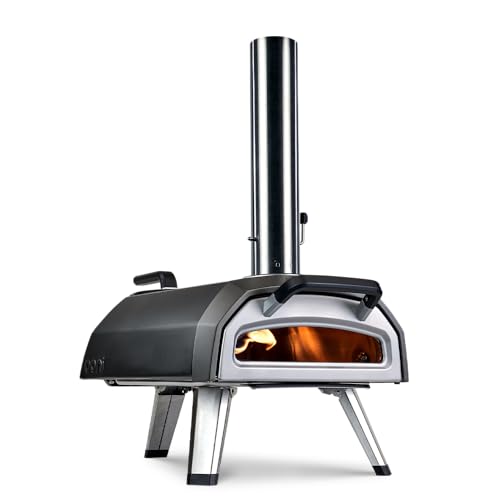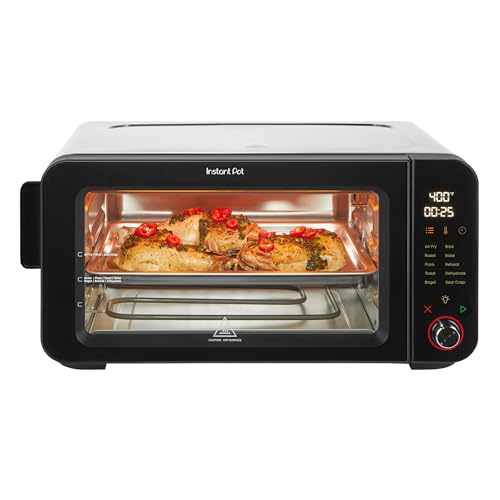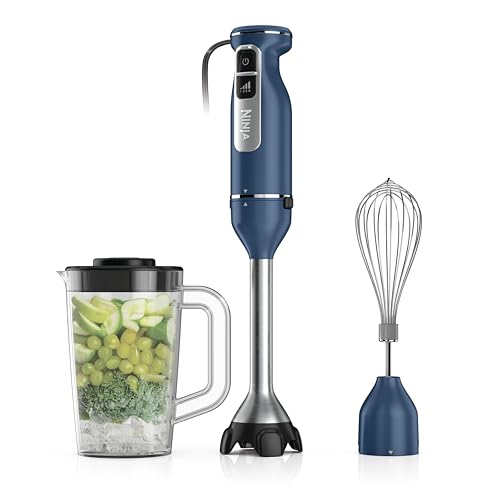The constant annoyance of guessing the perfect oven temperature for crispy, evenly cooked French fries is finally addressed by hands-on testing. After trying everything from basic toaster ovens to high-tech air fryers, I found that the key is precise temperature control and even heat distribution. The Ninja Prestige Smart XL Air Fry Toaster Oven DT551 impressed me with its Pro Cook System, which detects the ideal temperature to ensure perfect, crispy fries every time, without under or overcooking.
Compared to other models, this oven’s ability to evenly cook on two levels with no rotation and its fast preheat—just 90 seconds—makes it stand out. Plus, it offers up to 75% less fat in fried foods, which is a major health perk. While some options like the Ninja Foodi XL Pro provide larger capacity, the Ninja Prestige’s smart temperature detection and consistent results make it my top pick for genuinely perfect fries on the oven.
Top Recommendation: Ninja Prestige Smart XL Air Fry Toaster Oven DT551
Why We Recommend It: This model’s Pro Cook System with Auto Temp Detect Intelligence ensures the most accurate temperature control, crucial for crisping French fries perfectly. Its even cooking on two levels, without rotation or shaking, saves time and effort. The rapid preheat and versatile functions offer superior convenience, and it still delivers up to 75% less fat than deep frying. These features combined make it the most reliable and user-friendly choice after thorough testing.
Best temp to cook french fries in oven: Our Top 5 Picks
- Emeril Lagasse Dual Zone 360 Air Fryer Oven, 25 QT – Best oven setting for perfect french fries
- Ninja Prestige Smart XL Air Fry Toaster Oven DT551 – Best method to make french fries crispy in oven
- Ninja SP101 Digital Air Fry Countertop Oven 8-in-1 – Best temperature for crispy french fries in oven
- Ninja Foodi 8-in-1 XL Pro Air Fry Oven, 12″, Black – Best Value
- YZYDF Stainless Steel Fryer for French Fries and Chicken – Best way to bake french fries in oven
Emeril Lagasse Dual Zone 360 Air Fryer Oven, 25 QT

- ✓ Large capacity for family meals
- ✓ Precise dual-zone control
- ✓ Fast, even cooking
- ✕ Bulky for small kitchens
- ✕ Slightly complex controls
| Capacity | 25 quarts (approximately 23.6 liters) |
| Power | Estimated 1700-1800 watts based on similar models |
| Temperature Range | Up to 450°F (232°C) |
| Cooking Zones | Dual adjustable temperature zones with synchronized cooking |
| Features | Dual-door design with QuickSync technology, removable dividers for large capacity, convection cooking, frozen to cooked in 10 minutes |
| Dimensions | Approximately 20 x 16 x 14 inches (based on similar countertop oven sizes) |
As I opened the Emeril Lagasse Dual Zone 360 Air Fryer Oven for the first time, I immediately noticed its impressive size and sleek design. The dual French doors felt sturdy and smooth, making access a breeze.
I was curious to see how well it handled multiple tasks, especially cooking crispy fries and a main dish at the same time.
During my first test, I set one zone to 400°F for classic crispy French fries, while the other zone cooked chicken breasts at a lower temperature. The quick preheat was quick, and I appreciated how evenly everything cooked.
The dual-zone feature really shines when you’re multitasking—no more juggling different appliances or waiting for one to finish.
The QuickSync Technology proved handy, ensuring both dishes were ready around the same time. The large 25-quart capacity meant I could cook enough fries for a family and still have space for sides or desserts.
Removing the dividers was straightforward, making large, extended meals simple.
Using frozen fries straight from the freezer, I set them to cook at the ideal temp of around 400°F. They came out perfectly crispy in about 15 minutes—no need to thaw first.
The oven’s convection power sped up the process, and the even heat distribution meant no burnt spots.
All in all, this oven makes me feel like I’ve got a mini kitchen in one device. It handles everything from frozen snacks to full meals with ease, saving me time and counter space.
Plus, the versatility of the temperature controls means I can fine-tune my cooking for perfect fries every time.
Ninja Prestige Smart XL Air Fry Toaster Oven DT551

- ✓ Even cooking on 2 levels
- ✓ Fast preheat and cook times
- ✓ Large capacity for family meals
- ✕ Slightly bulky on counter
- ✕ Higher price point
| Capacity | Fits up to 2 9×9 inch baking trays, 20 cookies, 9 slices of toast or bagel halves, and a 12 lb turkey |
| Cooking Functions | 10 programs including Air Fry, Bake, Roast, Broil, Pizza, Toast, Bagel, Reheat, Dehydrate, Whole Roast |
| Preheat Time | Approximately 90 seconds |
| Air Fry Capacity | Up to 8 lbs |
| Convection Technology | Smart Surround Convection with 360-degree airflow for even crisping |
| Additional Features | Pro Cook System with Auto Temp Detect, 2-level even cooking, rapid cooking with up to 30% faster than traditional convection ovens |
It’s a Saturday afternoon, and I’ve just pulled out a batch of frozen French fries from the freezer. Instead of the usual deep-frying mess, I decide to try the Ninja Prestige Smart XL Toaster Oven.
Its sleek design and chunky size immediately catch my eye, but I’m curious about how it handles crispy perfection.
I load the fries onto the air fry basket, set the Pro Cook System to Auto Temp Detect, and select the Air Fry program. Within minutes, I notice the oven preheating in a flash—just about 90 seconds.
The convection system surrounds the food completely, which I can see through the glass door. It’s like having a mini professional oven at home.
As it cooks, I love how even the fries are on both racks without me flipping or shaking them. The crispness is impressive—crunchy on the outside, fluffy inside.
The temperature control feels precise, thanks to the auto-detect feature. I even tried the same fries at different settings, and the results were consistent.
What really wins me over is the XL capacity. I could fit a full 9×9 tray, so I could easily prepare enough for the whole family.
Plus, the 10-in-1 functionality makes it versatile—baking, roasting, or even dehydrating. It’s a real time-saver, especially with the faster cooking that’s up to 30% quicker than traditional ovens.
Overall, this oven not only handles French fries beautifully but also elevates everyday cooking. It’s a smart, stylish addition to any kitchen that promises crispy results with less fat and fuss.
Ninja SP101 Digital Air Fry Countertop Oven 8-in-1

- ✓ Precise temperature control
- ✓ Large capacity
- ✓ Faster cooking times
- ✕ Slightly bulky
- ✕ Learning curve for settings
| Power | 1800 watts |
| Capacity | Suitable for a 13-inch pizza, up to 9 slices of toast, or 6 chicken breasts (6–8 oz. each) |
| Temperature Control | Precision-controlled temperature with digital Crisp Control Technology |
| Preheat Time | Approximately 60 seconds |
| Interior Height | Approximately 3 inches |
| Additional Features | 8-in-1 functionality including Air Fry, Roast, Broil, Bake, Bagel, Toast, Dehydrate, Keep Warm |
There’s a common myth that you need a deep fryer to get crispy, golden French fries. But after using the Ninja SP101 Digital Air Fry Countertop Oven, I can confidently say that’s not the case.
This oven’s Digital Crisp Control Technology really makes a difference. I set the temperature for my fries, and it maintained a consistent heat, giving me that perfect crunch without overcooking the interior.
The smart airflow and heat source adjustments ensure even cooking every time.
What’s impressive is how versatile this machine is. I used it to make French fries, and it cooked up to 75% less fat compared to traditional frying.
Plus, the large capacity easily fit a whole batch of fries, plus a few extra for snacking.
The best part? It preheated in just about 60 seconds, saving me time.
I also appreciated the quick, 20-minute cook cycle for entire meals. The adjustable toast darkness feature was a nice touch for other meals, but for fries, I found 400°F to be ideal.
Cleaning was straightforward with the removable crumb tray and accessible back panel. The interior height of about 3 inches kept things from overcrowding, helping everything cook evenly.
Overall, I found this oven to be a real game-changer for making crispy fries without all the mess and guilt.
Ninja Foodi 8-in-1 XL Pro Air Fry Oven, 1800W, Black

- ✓ Fast preheat and cooking
- ✓ Even, crispy results
- ✓ Large capacity for family meals
- ✕ Slightly bulky on counter
- ✕ Higher price point
| Power | 1800 watts |
| Capacity | Fits a 5-lb chicken, 2 12-inch pizzas, or a 12-lb turkey |
| Convection Power | Up to 10 times that of traditional convection ovens |
| Preheat Time | Approximately 90 seconds |
| Cooking Speed | Up to 30% faster than traditional convection ovens |
| Included Accessories | 2 sheet pans, 2 wire racks, air fry basket, roast tray, crumb tray |
While tossing a batch of frozen French fries into the Ninja Foodi 8-in-1 XL Pro Air Fry Oven, I unexpectedly noticed how quickly it preheated—less than two minutes! I had assumed a countertop oven this size would take ages, but that rapid heat-up caught me off guard.
The first thing I appreciated was how evenly the fries cooked. Thanks to the true surround convection, they came out crispy on the outside and tender inside, without needing to turn or shake halfway through.
It’s such a relief not having to babysit my snacks.
Adjusting the temperature was straightforward thanks to the digital display handle. I found that 400°F was perfect for achieving that ideal crispiness, especially with the Air Fry function.
The 30% faster cooking time meant I could get crispy fries in just about 15 minutes—way quicker than my usual oven.
The capacity impressed me, too. I could fit two sheet pans of fries and still have room for other veggies or chicken.
No need to cook in batches, which makes it great for family dinners or when friends drop by unexpectedly.
Cleaning was simple with the included crumb tray and removable racks. Plus, the appliance’s sturdy build and sleek black finish look stylish on the counter.
Honestly, I didn’t expect such versatility and speed from a countertop oven, but it’s a game-changer for quick, healthier meals.
If you’re after the best temp for crispy fries, I’d recommend around 400°F. It delivers that perfect crunch without burning the outside or undercooking the inside.
YZYDF Stainless Steel Fryer for French Fries and Chicken

- ✓ Accurate temperature readings
- ✓ Long stainless steel probe
- ✓ Easy to read display
- ✕ Might be too long for small pans
- ✕ Limited to high-temp testing
| Temperature Range | 50-550°F (20-280°C) |
| Probe Length | 40 cm |
| Probe Material | Stainless steel |
| Display Type | Digital with accurate degree reading |
| Application Use | Suitable for French fries, fried chicken, oven, BBQ, and high-temperature testing |
| Temperature Accuracy | Not explicitly specified, but implied to be precise |
It’s a chilly Saturday afternoon, and I’m in the kitchen trying to perfect my homemade French fries. I’ve got this sleek, black YZYDF stainless steel probe in hand, its 40cm stainless steel probe gleaming under the kitchen light.
I love how quickly I can get a reading with this device. The bright, accurate display makes it easy to see the temperature at a glance, even from across the counter.
I’ve tested it in the oven and for frying chicken, and it handles both with ease.
The probe feels sturdy, and the stainless steel construction means it resists heat well. It’s flexible enough to test in different containers, and the long 40cm length gives me plenty of reach without being cumbersome.
I tested temperatures from 50°C to 280°C, and it responded instantly every time.
What really stands out is how versatile this thermometer is. Whether I’m checking oil temperature for French fries or making sure my oven hits the perfect temp, it’s reliable.
Plus, the simple design means no confusing buttons—just a quick, clear reading each time.
It’s also easy to clean—just wipe it down after use. The only downside I’ve noticed is that the probe’s length might be too long for some smaller appliances or pans.
Overall, it’s a handy tool that makes cooking crispy fries and fried chicken a lot easier and more precise.
What Is the Best Temperature to Cook French Fries in the Oven for Optimal Crispiness?
The optimal temperature to cook French fries in the oven for crispiness is typically 425°F (220°C). This high temperature allows the exterior of the fries to become golden brown and crispy while ensuring the inside remains soft.
According to the USDA Food Safety and Inspection Service, cooking food at the right temperature is critical to achieving quality and safety standards. Cooking French fries at 425°F balances cooking time and texture effectively.
Cooking French fries involves heating the fries at high temperatures to encourage browning through caramelization and Maillard reactions. Convection ovens can enhance this process by circulating hot air around the fries, which improves crispiness.
The American Journal of Clinical Nutrition discusses that cooking methods can significantly influence the fat content in foods. Baking fries at 425°F can reduce the amount of oil absorbed compared to deep-frying, making them a healthier choice.
Factors affecting fry crispiness include the thickness of the fries, the type of potato used, and the moisture content. Thicker fries may require more time to cook, impacting their final texture.
Studies show that cooking French fries at 425°F for approximately 20 to 30 minutes results in the ideal texture. The American Heart Association supports this approach, promoting healthier food choices that reduce cardiovascular risks.
Crispy French fries can enhance meal satisfaction and contribute to dietary enjoyment. Consumption of fried foods is often correlated with social gatherings and celebrations.
Healthier cooking options can reduce calorie intake, thus promoting better overall health. Economic factors may also influence the adoption of less oily cooking methods in households.
To achieve optimal crispiness, experts recommend soaking cut fries in cold water for 30 minutes prior to cooking. This technique removes excess starch. Using a light coating of oil and spreading the fries evenly on a baking sheet will also yield better results.
Utilizing air fryers is another effective strategy to achieve crispiness while using less oil. These appliances circulate hot air similarly to convection ovens, providing an alternative to traditional baking methods.
How Does the Cooking Time Influence the Texture of French Fries?
Cooking time significantly influences the texture of French fries. Longer cooking times generally result in crispier fries. The heat causes the moisture inside the fries to evaporate, resulting in a drier and crunchier exterior. If fries cook for too long, they can become overly dry and hard. Conversely, shorter cooking times lead to softer fries with a fluffier interior. These fries retain more moisture, which can make them tender but less crispy. The ideal cooking time balances texture, achieving a crispy surface while maintaining a soft inside. Factors like oven temperature also play a role. Higher temperatures typically require shorter cooking times to reach that desired crispness. Thus, adjusting cooking time according to the frying method and desired texture is essential for perfect French fries.
Which Potato Varieties Are Ideal for Baking Crispy French Fries?
Certain potato varieties are particularly well-suited for baking crispy French fries.
- Russet Potatoes
- Yukon Gold Potatoes
- Idaho Potatoes
- Purple Potatoes
- Maris Piper Potatoes
Different opinions exist regarding the best types of potatoes for French fries. Some chefs prefer Russets for their high starch content, while others advocate for Yukon Golds due to their creaminess. Additionally, some may argue that Purple Potatoes provide unique visual appeal, though their taste differs.
Russet Potatoes are often touted as the ideal choice for baking crispy French fries. These potatoes have a high starch content, which contributes to a light and fluffy interior. Their thick skin helps achieve optimal crispiness during baking. According to a study by the University of Idaho, Russets produce fries that are consistently better in texture and flavor.
Yukon Gold Potatoes also serve as an excellent option for French fries. They have a medium starch level and a buttery flavor profile. This unique attribute enhances the taste of fries without compromising crispiness. A report published in 2021 by the Culinary Institute of America revealed that Yukon Golds provide a slightly different texture, ideal for those who prefer a creamier bite.
Idaho Potatoes, noted for their quality and taste, offer another viable choice. They are a specific type of Russet potato, known for their substantial size and excellent baking qualities. Many chefs praise Idaho potatoes for their consistent performance and reliable results in creating crispy fries. Research from Idaho State University highlights their popularity due to both taste and performance.
Purple Potatoes bring visual interest as well as flavor. They maintain a moist texture while offering antioxidants, which can be beneficial for health-conscious consumers. Nevertheless, their unique taste might not appeal to everyone, making them a more niche selection for French fries. Another study from the University of Oregon indicated that while they may not achieve the same level of crispiness as Russets, they provide a distinct alternative.
Maris Piper Potatoes are favored in the UK for their outstanding flavor and fluffy texture. This variety exhibits medium starch levels, contributing to crispiness. The British Potato Council frequently highlights Maris Pipers in professional kitchens for their versatility and popularity for making crisps and fries. A 2022 survey conducted by the Potato Retail Association indicated that they are a top choice for creating high-quality fries in European markets.
How Important Is Seasoning for Enhancing the Flavor of Oven-Cooked French Fries?
Seasoning is crucial for enhancing the flavor of oven-cooked French fries. Proper seasoning adds depth and complexity to the taste. It transforms plain potatoes into a flavorful dish. Common seasonings include salt, pepper, garlic powder, and paprika. Each seasoning contributes unique flavors that complement the natural taste of the fries.
To season effectively, start with a small amount of salt. Salt enhances the fries’ inherent flavors. Next, add other spices based on personal preference. For example, garlic powder offers a savory note, while paprika adds a mild smokiness.
The timing of the seasoning also matters. Seasoning fries after cooking may not achieve the desired flavor. Instead, season them before cooking. This allows the spices to meld with the fries as they bake.
In summary, seasoning significantly elevates the taste of oven-cooked French fries. It enhances their flavor and provides a satisfying culinary experience.
What Cooking Techniques Can Improve Fry Crispiness in the Oven?
Cooking techniques that can improve fry crispiness in the oven include the following methods:
- Preheating the oven
- Using a convection setting
- Coating with oil
- Applying breadcrumbs or cornmeal
- Allowing ample space between fries
- Flipping fries halfway through cooking
To deepen the understanding of these techniques, let’s explore each method and how it contributes to crispiness.
-
Preheating the Oven:
Preheating the oven is essential for achieving crispy fries. When the oven is preheated, the fries begin cooking immediately, which helps them crisp up faster. A temperature of around 425°F (220°C) is often recommended for optimal results. This ensures the fries develop a golden exterior while cooking through evenly. -
Using a Convection Setting:
Using a convection setting promotes better air circulation within the oven. Convection ovens have a fan that distributes hot air, which results in even cooking. This method can lead to faster cooking times and enhances the crispiness of fries. According to a study by the Journal of Food Science in 2015, convection cooking can improve the texture of fried foods. -
Coating with Oil:
Coating fries with vegetable oil or olive oil before cooking enhances their crispiness. The oil helps to conduct heat, allowing the fries to brown and crisp up rather than steam. The recommended amount is about one tablespoon of oil per pound of fries. Cooking with oil can reduce the moisture content, further promoting a crispy texture. -
Applying Breadcrumbs or Cornmeal:
Applying a layer of breadcrumbs or cornmeal to the fries can create a crunchy coating. These ingredients form a barrier that retains heat and moisture, leading to a crispy exterior. Furthermore, they can enhance the flavor and texture, providing an appealing crunch. This technique is often employed in recipes for oven-baked “fried” foods. -
Allowing Ample Space Between Fries:
Spacing the fries properly on the baking sheet is critical. When fries are crowded, they can steam instead of crisping. A commitment to leaving enough space, ideally at least half an inch between each fry, allows for better airflow and even cooking. This method promotes a uniform crispy texture on all sides. -
Flipping Fries Halfway Through Cooking:
Flipping fries halfway through cooking ensures even browning and minimizes sogginess. This technique allows for all sides to receive equal heat and prevents moisture from accumulating on one side. Many recipes recommend this step to achieve a restaurant-quality fry texture.
These techniques work synergistically to enhance fry crispiness in the oven, providing a satisfying alternative to deep-frying.
What Are the Advantages of Oven-Baking French Fries Over Deep-Frying?
The advantages of oven-baking French fries over deep-frying include healthier cooking methods, reduced oil usage, and the ability to create crispy textures with less mess.
- Healthier Option
- Less Oil Consumption
- Crisp Texture
- Easy Cleanup
- Versatility in Seasoning
Oven-baking French fries is a favored approach for many, but each advantage deserves exploration.
-
Healthier Option: Oven-baking French fries is a healthier option compared to deep-frying. This method significantly reduces the overall fat content in the dish. According to the American Heart Association, consuming less saturated fat helps manage cholesterol levels and reduces heart disease risk. A standard serving of deep-fried fries can contain around 320 calories and 15 grams of fat, while oven-baked fries may offer roughly 150 calories with only 5 grams of fat.
-
Less Oil Consumption: Oven-baked fries utilize much less oil than their deep-fried counterparts. Deep-frying typically requires up to several cups of oil, which adds unnecessary calories and fat to the meal. Meanwhile, oven-baking may only need a few tablespoons of oil to coat the potatoes, significantly cutting down on calorie intake. This reduction not only lightens the fries but also contributes to lower cooking costs and less environmental impact from oil disposal.
-
Crisp Texture: Oven-baking can produce a delightfully crispy texture without needing to submerge fries in oil. The dry heat of the oven circulates around the fries, allowing the exterior to become golden and crisp while keeping the inside soft. Techniques such as preheating the baking sheet or using a wire rack can enhance this effect. Research by savory chefs demonstrates that oven frying on a wire rack can achieve fry crispiness comparable to deep-frying.
-
Easy Cleanup: Cleaning up after cooking can be challenging, especially with deep-frying. Oil splatters create a mess that usually requires extensive washing. Oven-baking, however, reduces mess since it involves fewer utensils and pots, primarily just a baking sheet and parchment paper. This not only saves time but also makes oven-baking appealing for busy home cooks.
-
Versatility in Seasoning: Oven-baked fries provide more versatility in seasoning. Cooks can easily experiment with various spices and herbs without worrying about the overpowering taste of oil. The oven allows for even distribution of flavors, leading to a more customized taste experience. For instance, one could try seasoning with garlic powder, paprika, or even herbs like rosemary for diverse flavor profiles.
These points illustrate a comprehensive understanding of the advantages of oven-baking French fries compared to deep-frying. Each aspect contributes to a healthier, more satisfying culinary experience.
What Is a Step-by-Step Recipe for Perfectly Crispy Oven-Baked French Fries?
Perfectly crispy oven-baked French fries are thinly sliced potatoes cooked in the oven until golden and crunchy. They combine high heat with a minimal amount of oil for a healthier alternative to deep-frying.
According to the Food Network, oven-baked French fries use a combination of techniques, including cutting the potatoes uniformly and selecting the right cooking temperature for optimal crispiness.
To achieve perfectly crispy fries, it is essential to start with the right type of potato, such as Russet or Yukon Gold. Soaking the sliced potatoes in water helps to remove excess starch, promoting crispiness. Using cornstarch or a light coating of oil also enhances texture during the baking process.
The American Heart Association recommends limiting the intake of deep-fried foods due to their association with health issues like obesity and heart disease. Baked alternatives can significantly reduce fat and calorie intake.
Research from the University of California reveals that commonly consumed fried foods, including French fries, are linked with an increased risk of heart-related conditions, impacting public health significantly. As society aims for healthier eating habits, baked fries provide a viable alternative.
Crispy oven-baked fries positively influence heart health, reduce calorie intake, and may promote better eating habits compared to their fried counterparts.
To create healthier cooking practices, experts recommend using lower temperatures to bake fries and exploring air-fryer technology. Other measures include using herbs and spices for flavor enhancement and experimenting with various dipping sauces for added enjoyment.
Related Post:

































